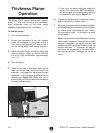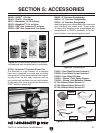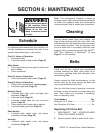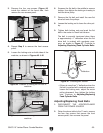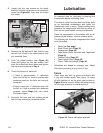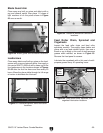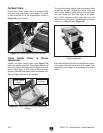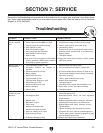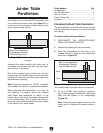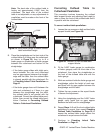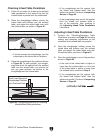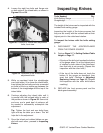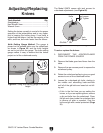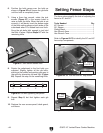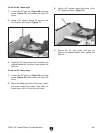
-38-
G0675 10" Jointer/Planer Combo Machine
Symptom Possible Cause Possible Solution
Outfeed table does
not lock.
1. Table lock lever engaged when table is
being closed.
1. Disengage table lock lever, lower table, then engage
lever.
Outfeed table will
not close.
1. Table lock arm stuck. 1. Push lock arm pin out; lubricate as needed.
Excessive snipe
(gouge in the end
of the board that is
uneven with the rest
of the cut).
1. Operator pushing down on trailing end of
workpiece.
2. Workpiece is not supported as it leaves the
planer.
1. Lift up on the trailing end of the workpiece as it
enters and leaves the planer.
2. Support the workpiece as it leaves the outfeed end
of the planer.
Workpiece stops/
slows in the middle
of the cut.
1. Taking too heavy of a cut.
2. Pitch and glue build up on planer
components.
1. Take a lighter cut.
2. Clean the internal cutterhead components with a
pitch/resin dissolving solvent.
Workpiece feeds
erratically.
1. Rubber lining on rubber feed rollers has
eroded excessively.
1. Replace feed rollers (Page 47).
Chipping (consistent
pattern).
1. Knots or conflicting grain direction in wood.
2. Nicked or chipped knife.
3. Taking too deep of a cut.
1. Inspect workpiece for knots and grain direction; only
use clean stock.
2. Replace the knife (Page 43).
3. Take a smaller depth of cut. (Always reduce cutting
depth when surface planing or working with hard
woods.)
Fuzzy grain. 1. Wood may have high moisture content or
surface wetness.
2. Dull knives.
1. Check moisture content and allow to dry if moisture
is too high.
2. Replace the knives (Page 43).
Long lines or ridges
that run along the
length of the board
1. Nicked or chipped knives. 1. Replace knives (Page 43).
Uneven knife marks,
wavy surface,
or chatter marks
across the face of
the board.
1. Knives not adjusted at even heights in the
cutterhead.
2. Worn cutterhead bearings.
1. Adjust the knives so they are set up evenly in the
cutterhead (Page 43).
2. Replace cutterhead bearings.
Glossy surface.
(Planer)
1. Knives are dull.
2. Cutting depth too shallow.
1. Replace the knives (Page 43).
2. Increase the depth of cut.
Chip Marks
(inconsistent
pattern). (Planer)
1. Chips aren't being properly expelled from
the cutterhead.
1. Use a dust collection system.
Board edge is
concave or convex
after jointing.
(Jointer)
1. Board not held with even pressure on infeed
and outfeed table during cut.
2. Board started too uneven.
3. Board has excessive bow or twist along its
length.
4. Insufficient number of passes.
1. Hold board with even pressure as it moves over the
cutterhead.
2. Take partial cuts to remove the extreme high spots
before doing a full pass.
3. Surface plane one face so there is a good surface to
position against the fence.
4. It may take 3 to 5 passes to achieve a perfect edge,
depending on starting condition of board and depth
of cut.



